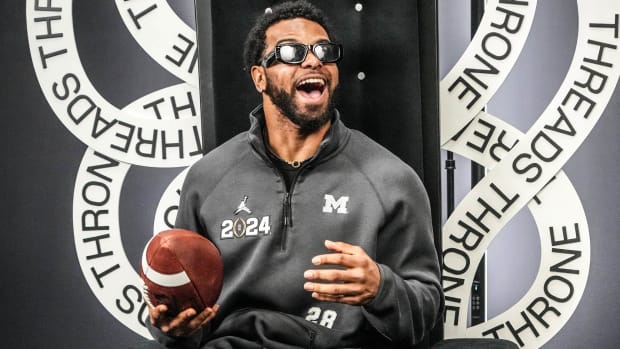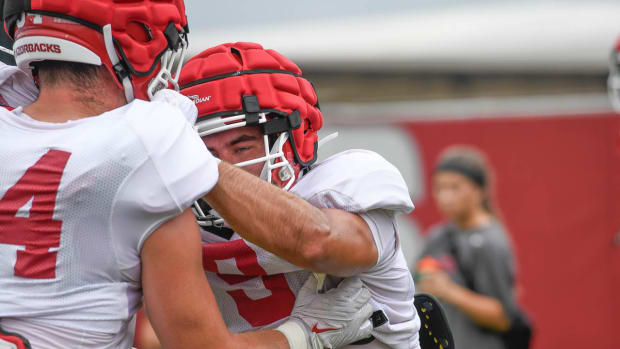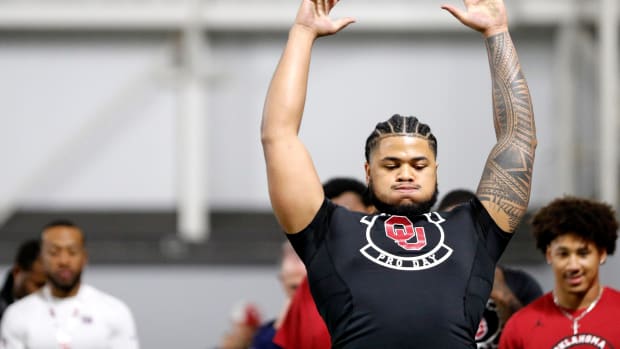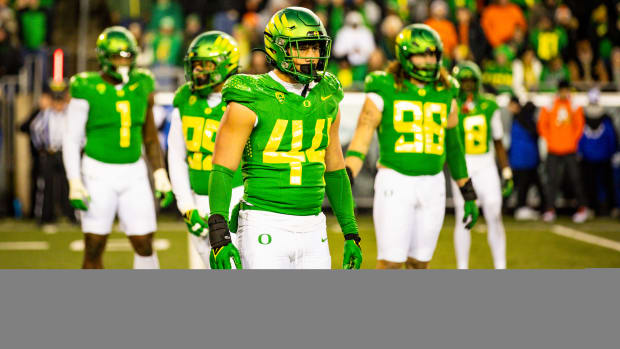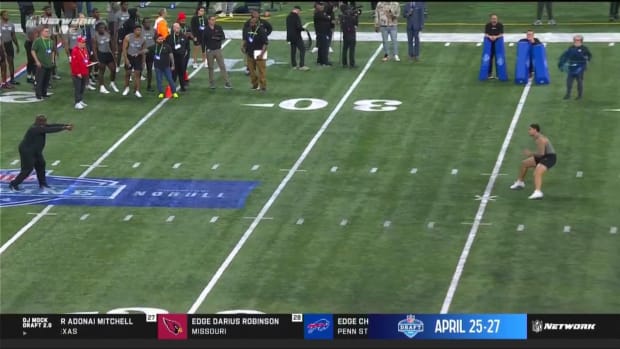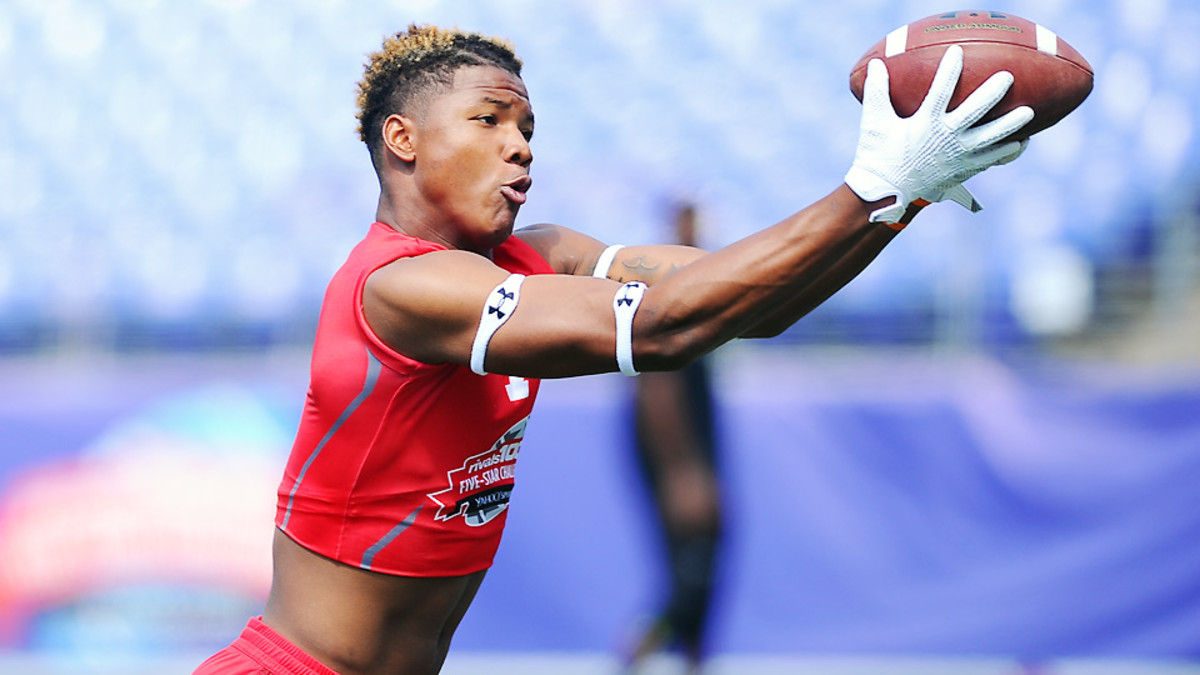
Top recruits says cost-of-attendance stipends not a big factor in decisions
HUNT VALLEY, Md. — At the NCAA’s annual convention in January, schools from the five richest conferences voted to increase the value of scholarships to cover the full cost of attending college.
The vote, which took place just months after the college governing body approved a new structure allowing for more rule-making autonomy, was framed as a victory for the Power Five and its student-athletes. There was some consternation, however, over whether other leagues* would be able to afford the expense.
Within the Power Five, another subplot emerged: Could the new benefit be used as a recruiting tool? Schools’ cost-of-attendance figures vary based on a number of factors, including whether a student hails from the same state as the school in question. Financial aid offers are not required to allot specific amounts for each expense.
Rashan Gary's emergence as the top defensive end recruit in the '16 class
Actual variations in the cost of living at different schools and the latitude afforded in determining the figures, not to mention the pressure financial aid officers face from different factions to change them—in both directions—create disparities between schools. For example, Texas Tech is one of five programs that offer more than $5,000 per year, while Michigan State is one of nine schools that offer less than $2,000, according to an April analysis from The Chronicle of Higher Education.
Some programs have already raised concerns about the discrepancies. Last month the SEC created rules requiring schools to file reports to the league office outlining the methods used to determine their cost-of-attendance figures and the value of the “other expenses” related to those figures.
In an age in which coaches are on such high alert to possible recruiting disadvantages that SEC coaches bristle at the prospect of Big Ten coaches appearing at camps in the Southeast, it’s not hard to see why programs—in and outside of the SEC—may be wary of how the new spending allowance could potentially affect their ability to land prospects. If one institution can offer an additional $2,000 or more per year in cost-of-attendance money than another institution, could that serve as the deciding factor in a player’s choice of school?
school | stipend |
Tennessee | $5,666 |
Auburn | $5,586 |
Louisville | $5,202 |
Mississippi State | $5,126 |
Texas Tech | $5,100 |
Penn State | $4,788 |
TCU | $4,700 |
Oklahoma | $4,614 |
Oklahoma State | $4,560 |
Ole Miss | $4,500 |
With the recruiting class of 2016 the first group to go through its senior year with cost-of-attendance stipends on the table, many wondered how those stipends would impact prospects' decisions. Yet as the recruits continue to evaluate prospective schools with less than seven months before National Signing Day, the preliminary effect appears to be minimal.
Already a star, Georgia QB commit Jacob Eason hopes to live up to hype
Many of the prospects who spoke to SI.com in June at the Rivals100 Five-Star Challenge said they either were not aware of or had not heard coaches discuss cost of attendance figures at great length. Most said the disparities would not impact their decisions, though many expressed interest in learning more about the cost-of-attendance legislation.
N’Keal Harry, a standout wide receiver at Chandler (Ariz.) High who counts more than 10 scholarship offers from Power Five programs, said he did not know schools could start offering money to cover the incidental costs of attending college. However, Harry said it would matter to some degree if a school could offer a few thousand than another school. “I mean, it’s a little bit of a factor,” he said. “But I just want to end up at a place where I fit in best and where I mesh with the coaches and the players and it’s just a good place for me.”
Meanwhile, C.J. Pollard, a four-star safety from Junipero Serra (Calif.) High, said that although he had not been informed about the new rule permitting programs to offer money to cover the cost of attendance, the ability for certain programs to offer more than others would definitely factor into his thinking process. “That’s big,” Pollard said. “That would matter a lot if they could offer that much more. Because some situations are different than others—not saying mine in particular. But, you know, it’s nice.”
school | stipend |
Boston College | $1,400 |
USC | $1,580 |
Syracuse | $1,632 |
Georgia Tech | $1,720 |
Purdue | $1,760 |
Michigan State | $1,872 |
Iowa | $1,938 |
Notre Dame | $1,950 |
West Virginia | $1,971 |
Minnesota | $2,194 |
Upon hearing about the new cost-of-attendance legislation, Rashard Lawrence, a defensive tackle from Monroe, La., who is rated the No. 78 player in the class of 2016, said he was interested in doing some research on the topic. “I haven’t heard anything about [it], but I’m about to go look it up now,” he said. Lawrence added that he didn’t think the stipend would matter much to him when he evaluates the merits of different programs. “I would personally think no, because they’ll take care of you wherever you go,” Lawrence said.
One highly regarded defensive back, Franklin (Calif.) High’s Lamar Jackson, said some coaches mentioned their programs’ cost-of-attendance figures. Asked how many of the programs recruiting him have discussed the stipends, Jackson said, “probably about 45 percent, not a whole lot.” He also downplayed the differences between schools’ figures. “The ultimate goal is playing in the NFL and getting a great education.” Added five-star receiver Nate Craig-Meyers, “It really doesn’t play a factor to me. They’re all full-ride scholarships.”
Although there was a range of responses, the players seemed less informed about the new legislation than might have been envisioned. There are a number of potential explanations for this, including the possibility that many coaches simply haven’t felt the need to tout their programs’ cost-of-attendance figures—or, in certain cases, make comparisons with other programs in a form of negative recruiting—to sway prospects. Maybe some players simply haven’t read much about the subject to this point.
Just an athlete? Khalil Tate looks to prove he can be a QB at the next level
The general lack of awareness counters the idea that cost-of-attendance scholarships will instantly become a powerful tool in heavyweight recruiting battles. Of course, it would be preferable to pool a larger sample of prospects, and the group who convened for the Five-Star Challenge by no means constitutes an average sample of high school talent. Most of the players in attendance were four or five-star recruits with scholarship offers from some of the nation’s top programs. Perhaps a more diverse cross-section of players would yield a different set of answers on the subject.
Regardless, expect more discussion about cost-of-attendance figures and their relation to recruiting in the months leading up to Signing Day. While many high-level recruits don’t seem to be seriously considering the figures right now, that certainly could change as they move closer to making their college decisions.
*Under the autonomy structure, the new legislation is categorized as “permissive,” which means schools outside the Power Five can enact it but are not required to do so.
